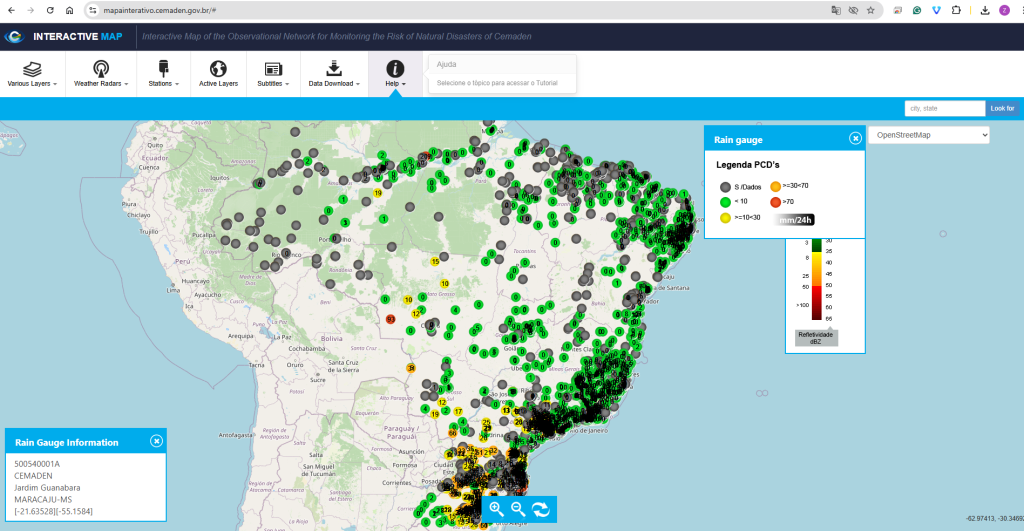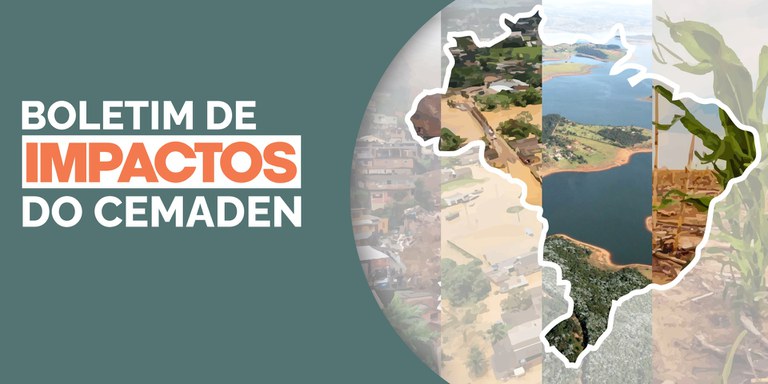National Center for Risk and Disaster Management – CENAD
Centro Nacional de Monitoramento e Alertas de Desastres Naturais – Cemaden/MCTI
Mapa Interativo da Rede Observacional para Monitoramento de Risco de Desastres Naturais do Cemaden
O MHEWC gostaria de agradecer ao governo brasileiro pela manutenção do geoportal do Centro Nacional de Gestão de Riscos e Desastres – CENAD.
https://mapainterativo.cemaden.gov.br

https://www.gov.br/cemaden/pt-br/assuntos/monitoramento
Monitoring
Report on Droughts and Impacts in Acre
RiSAF – Drought Risk in Family Farming
Bulletin on the Impacts of Hydro-Geo-Climatic Extremes on Strategic Activities for Brazil – 09/10/2025 YEAR 08 No. 83
Share:
Share via Facebook Share via Twitter Share via LinkedIn Share via WhatsAppCopy to clipboard link
Published on 10/15/2025 at 9:21 AM

Photo: Alan Pimentel
This edition of the Monthly Bulletin on the Impacts of Hydro-Geo-Climatic Extremes on Strategic Activities for Brazil, prepared by the National Center for Monitoring and Alerts of Natural Disasters (Cemaden), a Research Unit of the Ministry of Science, Technology and Innovation (MCTI), presents: (a) an assessment of occurrences and alerts for hydro-geo-climatic disasters (floods, flash floods and mass movements) for the month of September, and (b) a diagnosis and scenarios of rainfall extremes (droughts and floods) and their impacts on different economic sectors in Brazil for the October, November and December (OND) 2025 quarter.
Sending Alerts and Reporting Incidents
In September 2025, the Cemaden Situation Room issued 53 alerts, 38 of which were hydrological in origin and 15 of which were geological in origin.
Hydrological Risk: Current and Projected Situation
The situation of the levels of the main rivers in Brazil in relation to the climatological average of the hydrological stations of the National Water and Basic Sanitation Agency (ANA), referring to October 8th, is illustrated in Figure 1a . It can be observed that, in the northern portion of the North region, the rivers have levels above or close to the climatological average. Furthermore, in the northwestern portion of the Central-West region, in the eastern portion of the Northeast region, in the southeastern portion of the Southeast region, and in a large part of the South region, the river levels are also above or close to the average. On the other hand, many rivers located in the western and southeastern portions of the North region, in the western portion of the Northeast region, a large part of the Southeast region, mainly in the western portion, as well as in the eastern and southern portions of the Central-West region, have levels below the climatological average.Figure 1. Situation of river levels in Brazil on October 8th in relation to the climatology of hydrological measurement stations (a) and sub-seasonal flow forecast from October to November 2025 – ON (b).
The seasonal forecast for the next 45 days – ON of the Global Flood Warning System (GloFAS) model in Figure 1b , indicates a continued probability of flows above or well above the climatological average for the period in the northwestern portion of the North region, between the Juruá, Solimões and Negro rivers and between the states of Amapá and Pará, a probability of flows close to the average for the period in the eastern portion of the Northeast and Southeast regions and a large part of the South region of Brazil, and a probability above 75% for flows below the climatological average in the remaining areas of the country.
Impacts of Drought on Vegetation and Agriculture
The number of municipalities experiencing severe drought increased from 109 in August to 460 in September; however, there were no records of municipalities experiencing extreme or exceptional drought, as indicated by the Integrated Drought Index (IIS3, Figure 2a ). Meanwhile, moderate drought decreased from 1327 to 1394 municipalities, and mild drought decreased from 2010 to 1932. Over a six-month period, a decrease in drought severity was also observed ( Figure 2b ). The number of municipalities experiencing severe drought fell from 460 in August to 248 in September, with no records of extreme or exceptional drought. Moderate drought increased from 1386 to 1694 municipalities, and mild drought decreased from 2263 to 2016 municipalities. The central region of the country continues to concentrate the most critical areas, with the drought persisting in the corridor that encompasses parts of the Southeast (Minas Gerais and São Paulo), Midwest (Goiás and Mato Grosso), Northeast (Bahia and Piauí), and North (Tocantins and Pará).
The central region of the country continues to concentrate the most critical areas, with the drought persisting in the corridor that encompasses parts of the Southeast (Minas Gerais and São Paulo), Midwest (Goiás and Mato Grosso), Northeast (Bahia and Piauí), and North (Tocantins and Pará).Figure 2. Integrated Drought Index (IDI) for the month of September 2025 on the 3-month scale (IDI3, left) (a) and 6-month scale (IDI6, right) (b). Forecast of the Integrated Drought Index (IDI) for the month of October 2025 on the 3-month scale (c).
Projections from the Integrated Drought Index (IIS-3) for the end of October 2025 indicate a reduction in the number of municipalities experiencing moderate to extreme drought, signaling a trend towards easing drought conditions across the country ( Figure 2c ).
The description of the IIS estimate and the assessment of drought impacts at the national level and also on family farming can be consulted, respectively:
Drought Monitoring and Impacts Bulletin in Brazil.
RiSAF – Drought Risk Bulletin for Family Farming
We invite you to contribute information about the impacts of droughts in your region through the Drought Impact Registration and Assessment Form.
Impacts of Drought on Water Resources
The Standardized Bivariate Precipitation-Runoff Index (TSI) allows for the characterization and prediction of hydrological droughts in the main river basins that feed the country’s main hydroelectric power plants (HPPs), as well as the basins associated with water supply and navigability ( Figure 3 ).
In the Southeast and South regions, the Cantareira System showed a weakening of the drought, going from severe to moderate. In the sub-basin feeding the Jaguari Hydroelectric Plant, the most critical of the Paraíba do Sul River, the drought weakened from extreme to severe. In the Paranapanema River, the sub-basins of the Jurumirim and Capivara Hydroelectric Plants regressed from extreme to severe, while the Rosana Hydroelectric Plant maintained a stable condition of extreme drought. In Itaipu, the condition also remained extreme.
In the Central-West region, the Serra da Mesa hydroelectric dam basin (Tocantins River) recorded severe drought, after experiencing extreme conditions the previous month. The Paraguay River basins, at the Porto Murtinho and Ladário stations, maintained severe drought, an improvement compared to the extreme conditions observed previously, although significant water deficits accumulated in recent years still persist.
In the Northeast region, the basins of the Sobradinho (São Francisco River) and Boa Esperança (Parnaíba River) hydroelectric power plants remained in a state of severe drought.
According to forecasts for October 2025, the basins with the most critical drought conditions — such as those of the Paraná River (Itaipu and Paranapanema), lower Paraguay River (Ladário), middle and lower São Francisco River (Sobradinho), headwaters of the Tocantins River (Serra da Mesa), and Parnaíba River — are expected to remain stable, without significant recovery.Figure 3. Bivariate Drought Index (Rainfall-Runoff) – TSI 6 and 12 for the month of September (observed, left) and October 2025 (forecast, right). The colored boundaries represent the main monitored basins across the country with their respective drought classes (ranging from exceptional to weak drought) and the condition within normality. Source of observed data between January 1981 and September 2025: Precipitation (CHIRPS); and Runoff (National Water and Basic Sanitation Agency – ANA/National Electric System Operator – ONS). Source of predicted precipitation data for May: Climate Forecast System (CFS).Get More Information
For more detailed information, please consult the Impact Bulletin and also download the Impact Meeting presentation available for download at the links below.
Download the Impact Bulletin
. Download the Impact Meeting presentation . Watch the recording of the Impact Meeting.
Click here to register your email and receive an invitation to the Impact Meeting. Your participation is very important!
Important Notes
1. Reports with more detailed information on the current situation of the main water reserves and drought conditions throughout the country, as well as hydrological projections and possible drought impact scenarios, are available and updated on the Cemaden website ( https://www.gov.br/cemaden/pt-br ).
2. The information/products presented may not be used for commercial purposes, copied in whole or in part for reproduction in media, without the express authorization of Cemaden/MCTI and other bodies with which Cemaden maintains partnerships. Users must always cite the source of the information/data as Cemaden/MCTI. We emphasize that the generation and dissemination of information/products consider criteria of data quality and consistency.
3. We also note that the data from the natural disaster monitoring network available via the Interactive Map on the Cemaden website have not undergone any processing; therefore, there may be inconsistencies in this data.
Responsible Team
Director: Regina Célia dos Santos Alvalá
Responsible Coordinator: José A. Marengo
Scientific Reviewer of this Edition: José A. Marengo
Collaborating Researchers: Adriana Cuartas, Ana Paula Cunha, Alan Pimentel, Elisângela Broedel, Fabiani Bender, Larissa Silva, Lidiane Costa, Márcia Guedes, Marcelo Seluchi, Marcelo Zeri, Rafael Luiz.CategoryScience and Technology